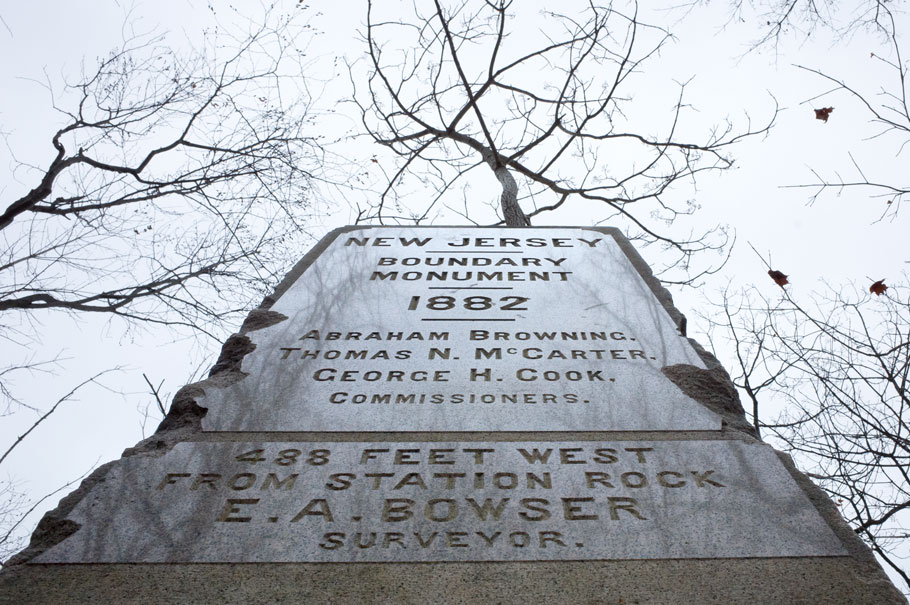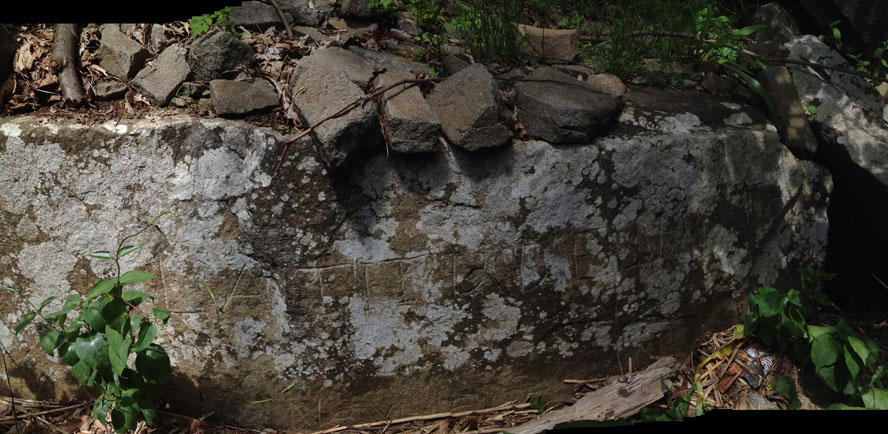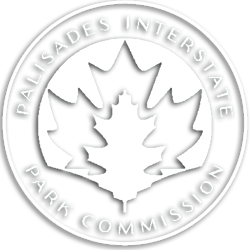Tales of the Eastern Witness
A “Cliff Notes” Story
January 2018
It’s one of those things in the park that seems to hide in plain sight: a gray granite stela that stands seven-and-a-half feet tall, atop a rock outcrop on the summit of the Palisades, just off the Long Path. Thousands of hikers pass within fifty feet of it every year. Some notice it, some don’t, but relatively few pause in their hikes to walk up to it and read the inscription carved in its polished face. (Fewer still will notice that there is a similar — yet different — inscription carved into the opposite face as well.) On most hiking maps it’s called out simply as “Border Monument” or “State Line Monument.” But it has another name too. It’s one we only learned after we decided to find out a bit more about this artifact, which predates the creation of the Palisades Interstate Park Commission by some eighteen years: the “Eastern Witness Monument.”

And, yes, we learned that it has a twin, too, a “Western Witness Monument,” which overlooks the Delaware River, almost fifty miles away. The two are known as “Witnesses” because neither is at the exact site it calls out. The Western Witness is “72¼ feet from … Tri State Rock,” while ours, the Eastern Witness, is “488 feet west from Station Rock.” Between these two points, Tri State Rock and Station Rock, runs the straight line that forms New Jersey’s northern border with New York.
Or what should be a straight line…
It is one thing to lay a ruler on a piece of paper in a palace in England and draw a straight line — which is, more or less, what the Duke of York did in 1664, when he (literally) put New Jersey on the map. (About ninety percent of the rest of the boundary — almost five hundred miles — is water, New Jersey being, in essence, a peninsula.) It is something else altogether, of course, to try to figure out where that line falls across fifty miles of forest and rugged little mountains and oozing swamp, where men want to buy and sell property, to build farms and dig holes in the mountainsides to mine for iron, and to do who knows what all else on this side of the Atlantic.
In 1718, it was noted by the Colonial government in New Jersey that along the line with New York, “many disputes and controversies” had occurred between landowners, “and a number of lawless men there, who elude the laws of both Provinces, and pay taxes and obedience to neither” were a continuing problem. To further complicate things, there was disagreement on where the line even began. Fifty-year-old maps and surveys, done with antiquated equipment, contributed to the confusion. Here along the Hudson, some claimed the line was to begin as far south as opposite Spuyten Duyvil (around Englewood Picnic Area in the park); others placed it as far north as Tappan Creek (around the town of Piermont, New York, today).
Things came to a head in the 1760s, and a Commission was formed by the two Colonies to correctly determine the starting points and then run a survey of the line, placing mile markers along it. The Commissioners carved a line in a large rock on the west shore of the Hudson to mark where the 41st degree of latitude met the shore, and on May 22, 1770, the surveyers started to move west from this point into Orangetown, only to find “many of the … inhabitants were assembled and were utterly averse to having the proposed line run, but on the contrary with many threats declared they were determined to prevent it.” Rattled by their reception, the surveyors “all agreed to begin on the Station Mahackamack [on the Delaware,] hoping the people [in Orangetown] would be better informed on their return…” So they worked their way east until June 7, “when they were stopped a few chains across Saddle River by at least 50 men.” They left the line to do some work across the Hudson, until, on June 14, they met again with the Orangetown residents, who — happily — “at last agreed that the line should be run…”
In 1772, a process to settle out the various claims that arose from re-adjusting the line was begun, and in 1774 stone markers were placed at each mile along the line. In April of 1775, the work of the Commission was duly accepted by each of the two Colonies. A few days later, in Massachusetts, the first shots of the American Revolution were fired at Lexington and Concord.
In 1785, New Jersey and New York — now states — agreed to continue to accept the 1775 agreement.
Ninety-nine years would pass before the line was again revisited. At the urging of New Jersey’s first State Geologist, George H. Cook, a new survey was conducted in 1874, to remap the line using more modern equipment and methods. With a young surveyor named Edward Bowser, Cook (the namesake of Cook College at Rutgers) reported that many of the Colonial mile markers were missing or had been moved. Furthermore, he and Bowser determined that the line was not truly straight. Due to inherent problems with the methods used, as well as compass interference from the iron ore in some of the mountains the surveyors crossed, the line made a slight arc to the south: this curve was all but imperceptible on any map, but about ten square miles of New York should, they found, be in New Jersey! (To avoid creating new difficulties, however, the two states would agree to keep the century-old line, southern arc and all.)
Cook’s work led to the creation of another Joint Commission between the states in 1881, which began to plan yet another survey to place new markers. The survey was begun on April 6, 1882, and completed on June 14. New granite markers, one for each mile, as well as at highway, railroad, and river crossings, were placed between June 24 and August 11. The Commissioners also proposed memorializing their work (and their names) with the two Witness Monuments.
They were able to locate the rock along the Hudson that had been marked over a century before with Latitude 41 north and a vertical line, New Jersey on one side of it, New York on the other. “By estimation,” they reported, “the rock weighs nearly eight tons, so that it is not likely to be moved by accident … but it lies immediately under the Palisades, where it is liable to be buried under the debris which falls from the rocks above … To avoid any danger to arise from its loss, and also to mark more conspicuously the terminus of the line, a pillar or monument of granite … has been set up on the boundary line where it crosses the highest part of the Palisades.”

The granite was cut from a quarry in Rhode Island. “This pillar is in one piece,” the Commission reported, “11½ feet long, and with a cross section of something over one foot by two feet; it weighs nearly three tons, and is set four feet down in an accurately cut hole in the rock, and fastened with cement mortar…” The report also noted, however, that along the way, the twin Witnesses got to have one minor adventure — before being set in place for the ages: “The setting of the monuments [was] delayed by a singular mistake of the … Railway officials, in sending them to Erie, Pennsylvania, so that several weeks passed before they were found and returned.…”
– Eric Nelsen –

